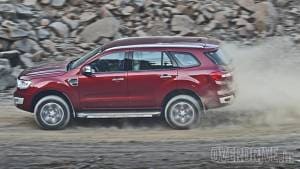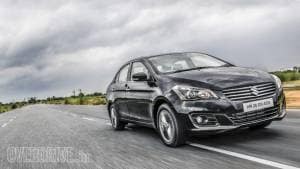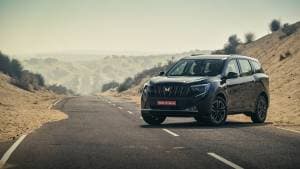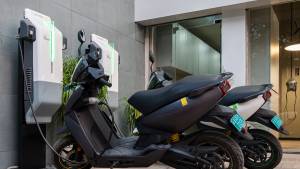Exclusive: Royal Enfield Himalayan road test review
When we rode the Royal Enfield Himalayan in Shimla, where Royal Enfield hosted the media rides, we got a fairly one-sided glimpse into the Himalayan. In tough conditions, the new Royal Enfield Himalayan excelled. It left us impressed. But it also raised a lot of questions. How would the new Royal Enfield be outside the Himalayan conditions? How would it be on the plains? Would it be exciting? Or would the Himalayan be a plane-Jane? Time to answer those questions!
Design, build and finish
The Royal Enfield Himalayan is an odd design. The company says that while it wanted to do an adventure tourer, it didn't want to go where the current segment is. The RE Himalayan, then, has a functional simplicity to it. There's an almost industrial focus to the design which I find very appealing. And I have to mention here that the motorcycle looks a lot better up close and in the flesh than in the pictures. There are angles from which the Himalayan looks awkward or disproportionate, but by and large, it's a handsome, spartan motorcycle that looks like a tool or a machine rather than the fancy, plastic-covered gargantua that pass for adventure tourers today.
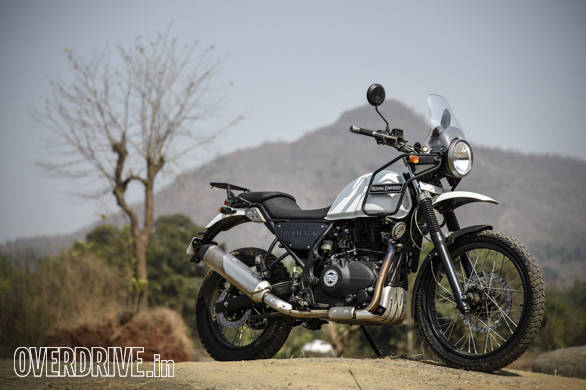 The Royal Enfield Himalayan isn't a pretty motorcycle but there's a appealing simplicity to its functional design that draws you to it
The Royal Enfield Himalayan isn't a pretty motorcycle but there's a appealing simplicity to its functional design that draws you to it
The details in the design that stand out for me are easy to spot. I like the idea of the frame that mounts on a crossbar under the tank and carries the weight of the headlight, meters and screen. The frame could be finished a lot, lot better though. In fact, welds on the Himalayan are really gnarly and ugly pretty much all over the motorcycle's frame. RE told us that their robotic welding machines will clean up shortly but as of now, be prepared for some unsightly welds.
I also like the little rack for gear on the back. I found it extremely handy to cinch my Kriegas on to while riding around two-up. I do think Royal Enfield should let customers know what the load rating on that wire rack is. I also couldn't find a sticker showing recommended tyre pressures or chain tension on the Himalayan.
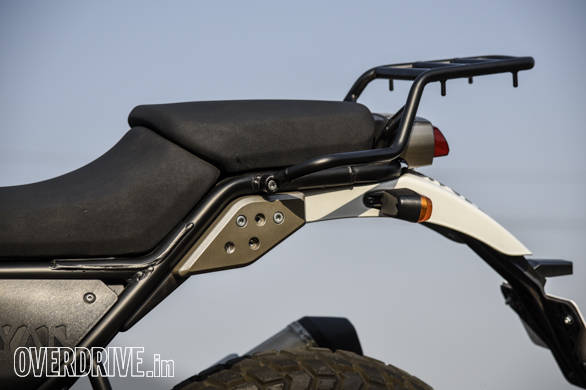 The pillion seat on the Royal Enfield Himalayan is comfortable enough but our rear seat testers noted that the knees feel a little high - they'd have liked a slightly lower peg position. No complaints on the seat though. The wee rack behind the seat proves very useful when taking gear and pillions out for rides together
The pillion seat on the Royal Enfield Himalayan is comfortable enough but our rear seat testers noted that the knees feel a little high - they'd have liked a slightly lower peg position. No complaints on the seat though. The wee rack behind the seat proves very useful when taking gear and pillions out for rides together
Overall, finish levels can stand considerable improvement on the Royal Enfield Himalayan. Just cleaning the welds up, especially, the half-tube that sits below the aft end of the rider's seat, would improve the quality perception of the Himalayan by a significant amount.
Build quality, though, is surprisingly good. We put this test RE Himalayan through a relentlessly hard 650km of testing in two days and we failed to rattle it. Multiple jumps and off-road excursions only caused one tiny issue. The Royal Enfield Himalayan wears many caps and most fell off. By that I mean the little plastic caps that cover recessed screws used to mount the headlight, and another two on the frame at the crossbar at the rear of the engine. Three of four caps had fallen off by the time we finished but the motorcycle was otherwise entirely rattle-free and feeling as well built as it did on day one.
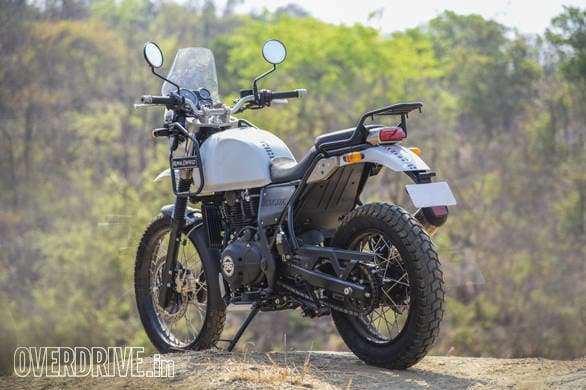 The chassis could be finished better on the Royal Enfield Himalayan but it's capabilities will surprise you
The chassis could be finished better on the Royal Enfield Himalayan but it's capabilities will surprise you
Engine, performance and economy
As you know the LS410 named engine in the Royal Enfield Himalayan is all-new. But it most certainly doesn't feel like a new engine. I'm not sure if Royal Enfield engineered it like this, but it feels more like an improved current engine than a brand-new one. This has pros and cons, naturally.
 The LS410, 411cc oil-cooled 2 valve SOHC single cylinder is all-new. But you'd be hard-pressed to imagine that. It sounds and goes a lot like RE's current engines. However, the Royal Enfield Himalayan's counterbalancer quells vibration well. The 5-speed gearbox is also new and it didn't miss a single shift on the whole test
The LS410, 411cc oil-cooled 2 valve SOHC single cylinder is all-new. But you'd be hard-pressed to imagine that. It sounds and goes a lot like RE's current engines. However, the Royal Enfield Himalayan's counterbalancer quells vibration well. The 5-speed gearbox is also new and it didn't miss a single shift on the whole test
On the plus side, the 24.5PS (at 6,500rpm) LS410 is a counterbalancer-equipped engine. Vibration is controlled well for the most part. Rev past 5,500rpm and you'll feel them. By this point, you will feel them in the seat, pegs as well as bars. However, the vibration is much stronger under acceleration than at steady speeds. So while pushing to higher speeds can feel shaky, holding those speeds is often much easier.
Over the highway miles we quickly realised that the RE Himalayan is happiest at 80kmph in top gear, just below 4,000rpm. This is the speed you default to when you allow yourself to unconsciously pick a speed based on feel. Peak torque, incidentally is 32Nm, between 4,000 and 4,500rpm. It feels quite cheerful up to 95kmph, just below 5,000rpm in top gear. Vibration starts shortly thereafter in the footpegs. Cruising at as much as 105kmph (5,200rpm, approx in 5th gear) is possible though opening the throttle to pass traffic at these speeds immediately produces a less than symphonic noise as well as vibration. Top speed is 129kmph on the Vbox, 134kmph indicated. The noise and vibration will likely preclude you from seeing this speed often. It's a similarly busy manner in which the Himlayan gets to 100kmph at full tilt, taking 10.52 seconds.
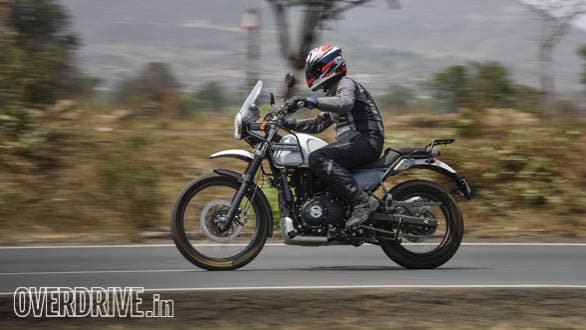 The Royal Enfield Himalayan runs effortlessly down the highway between 80 and 95kmph. Faster speeds are possible but you'll have to put up with some vibration in the pegs
The Royal Enfield Himalayan runs effortlessly down the highway between 80 and 95kmph. Faster speeds are possible but you'll have to put up with some vibration in the pegs
At this point, chances are RE haters are beginning to smirk at how weak the Himalayan's performance sounds. Well, wipe the snark off smug-mugs because the bike isn't slow. True it doesn't cruise as fast as I'd personally like but it certainly has a spring in its step. Between 2,500 and 4,500rpm, the Royal Enfield Himalayan has great torque. You don't hear much by way of a thump but you pass traffic easily and even on the highway, overtaking is just a matter of rolling the gas on.
On one commute, I was in a boisterous mood and decided to up the pace. As long as I used the gearbox to stay in the sweet spot, the Himalayan proved to be extremely swift and responsive. That torque, combined with its other abilities, makes this Royal Enfield a vastly superior commuter than any of the other RE motorcycles you can name.
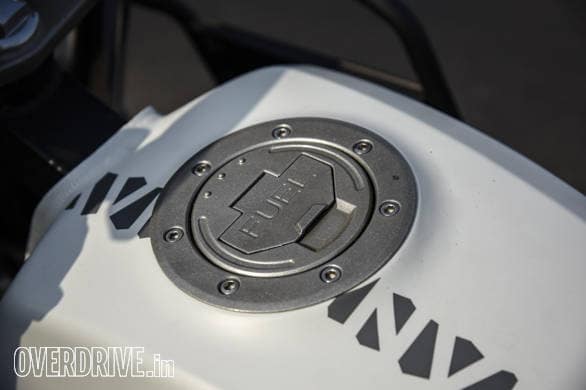 The word 'Fuel' on the Royal Enfield Hinalayan's gas tank cap continues to baffle us. It's a needless design flourish on a motorcycle that revels in its spartan simplicity
The word 'Fuel' on the Royal Enfield Hinalayan's gas tank cap continues to baffle us. It's a needless design flourish on a motorcycle that revels in its spartan simplicity
Economy? No surprises. The Royal Enfield Himalayan returned 28kmpl on our city cycles and 36 on the highway. That tots up to a neat 30kmpl overall. With a 15l tank, that's a range of 450km - eminently acceptable for a tourer.
At the beginning of this section, I told you that the LS410 feels like an improved old engine more than like an all-new engine, let me explain that. What I still don't fully like about the LS410 is that it sounds wheezy outside of its sweet spot. I cannot imagine why a modern, made-yesterday engine would sound and feel like this. There is also the surprise of tappet clatter a la old RE engines that arrived as soon as our economy runs, the gentlest phase of the road test, was complete. It's a bit strange that RE would be unable to quell this clatter that's almost a signature of their older engines. I do have to point out that the clamour didn't get worse once it started no matter how hard we pushed the bike, but still. We expect modern engines to be robust and healthy-sounding and the LS410 is some distance from that.
 It's a genuine tourer in every way. At 30kmpl overall the range is 450km and the saddle is comfy for hours too. Wish the screen was less tall or adjustable. It's great in cold weather but it hinders the view is slow, difficult conditions and stops airflow on hot days
It's a genuine tourer in every way. At 30kmpl overall the range is 450km and the saddle is comfy for hours too. Wish the screen was less tall or adjustable. It's great in cold weather but it hinders the view is slow, difficult conditions and stops airflow on hot days
Overall then, performance is good for the Himalayan in the context of other Royal Enfields. Vibration is a only an issue at high revs and torque flow in the sweet spot is effortless. But there is a valid question about the relationship of the performance to the displacement. But I'll come back to that.
Let's also not forget that at 182kg, the Royal Enfield Himalayan is a very heavy motorcycle. For perspective, the 675cc triple cylinder Triumph Street Triple is 1kg heavier. Or the 200cc 25PS KTM 200 Duke is a whopping 44kg lighter. Had the Himalayan been lighter, the engine's performance and economy both would have had a greater sheen to them.
Ride, handling and braking
Let's the get weakest of these three points out of the way first. Stopping the Royal Enfield Himalayan is a task. Not that the brakes lack force but it's the state of tune. The brakes offer a weak bite followed by a startlingly lazy buildup of force. Hard stops require a fair bit of lever travel before braking system shows that it doesn't lack force. I suspect that this state of relaxed tune was consciously chosen. It makes the brakes friendlier to new riders as well as more confidence-inspiring to use once off the safety and predictability of tarmac. They take getting used to. The problem is that the long fork travel (less feedback) as well as the need for control over braking off-road (low traction conditions) eliminates the possibility of a strong bite without a fail safe (ABS). Hence the soft tune. You do get used to it in time but the fact is that this is easily the softest, almost drum brake-like, disc setup we've tested in ages. That said, the lack of braking feedback is actually a bigger issue than any actual lack of brake force.
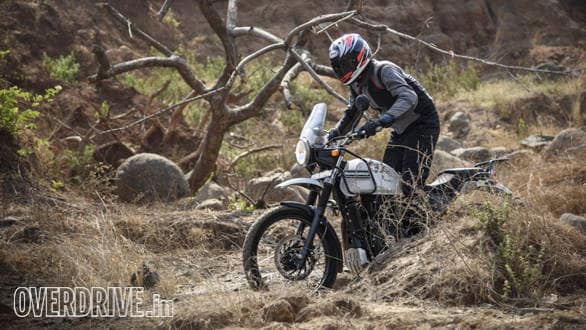 India's only genuine off-roader? Surprisingly, yes. The Royal Enfield Himalayan's 19-inch front wheel and superb chassis offer enough feedback, great friendliness and startling ability once the tarmac ends. You won't need to go to Ladakh to enjoy this motorcycle
India's only genuine off-roader? Surprisingly, yes. The Royal Enfield Himalayan's 19-inch front wheel and superb chassis offer enough feedback, great friendliness and startling ability once the tarmac ends. You won't need to go to Ladakh to enjoy this motorcycle
But the RE Himalayan chassis, from here on out, is the star of the show by miles and miles. The ride quality, for instance, is superb. The Himalayan sits on fairly straightforward suspension. Right side up 41mm telescopic forks up front with no adjustment but 200mm of travel. The rear is a long monoshock with a linkage, preload adjustment and 180mm of travel. But basic spec doesn't matter when you get the basics right. And that's what Royal Enfield has done.
It is almost impossible to bottom the forks despite their supple, almost soft feel. It is also very hard to induce wallow. What the Himalayan is, is graceful and unflappable. It's superbly poised on good roads and bad. It's comfortable and friendly off-road too. There's a noticeably stiffness to the initial travel that's evident off-road but it makes for additional feedback that gave me greater confidence without really adding any discomfort. The Himalayan's sophistication and ability in this regard is astonishing. We also jumped a number of speed breakers - just testing suspension, officer - as well as off-road bumps and crests. The Himalayan landed with control and precision every single time. Most impressive.
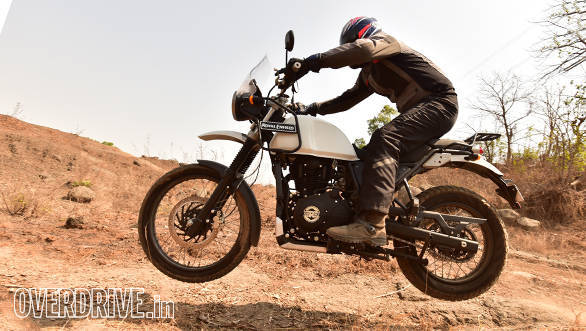 We landed jump after jump and marvelled at the composure and control that the chassis has over the goings-on. The Royal Enfield Himalayan begs for a snappier motor to go with the chassis in fast off-road conditions though
We landed jump after jump and marvelled at the composure and control that the chassis has over the goings-on. The Royal Enfield Himalayan begs for a snappier motor to go with the chassis in fast off-road conditions though
Handling, similarly, is of a very high order. Given the height and weight of the platform, one cannot expect the Royal Enfield Himalayan to be a corner carver of great precision or ability and it isn't. But it is both responsive and predictable, which makes riding it easy and confident. It leans naturally into corners and holds its line neatly. Mid-corner corrections require little effort and cause little drama. The superb suspension makes mid-corner bumps disappear and the RE Himalayan really is lightyears ahead of its Enfield siblings in the dynamics department. Off-road, the calm, friendly handling is a huge asset. It allows you to trust the motorcycle and carry on without freaking out.
The Ceat Gripp XL tyres on the Royal Enfield Himalayan are vexing. They're terrific in bad-road and off-road conditions. They prove grippier than you think and the utter lack of wear despite our hard 650km suggests they'll last a while too. On the flip side, on good tarmac, they demand trust. You cannot really feel the contact patches and it comes down to your ability to have faith in their grip.
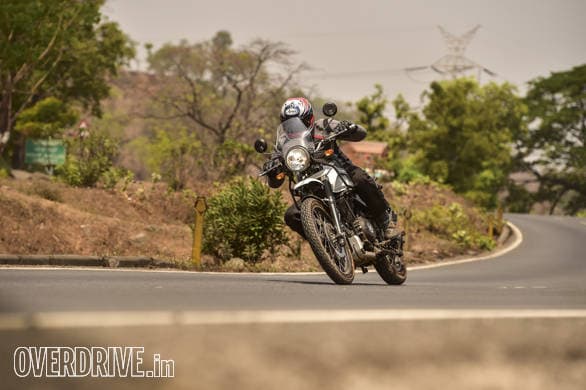 The Royal Enfield Himalayan corners well. It's predictable and natural but not overtly quick to turn. The big issue is that you cannot really feel the contact patches and the Ceat Gripp XL tyres are far better off-road than on tarmac. Cornering fast requires stead my inputs and a little faith
The Royal Enfield Himalayan corners well. It's predictable and natural but not overtly quick to turn. The big issue is that you cannot really feel the contact patches and the Ceat Gripp XL tyres are far better off-road than on tarmac. Cornering fast requires stead my inputs and a little faith
All told, the RE Himalayan's chassis is the big shining highlight of the motorcycle. It's so good that I'm ready to compare it to thoroughly modern motorcycles and expect to see it arrive at or near the top. Unfortunately, it also serves to cast a less flattering light on the LS410. Both parts of the motorcycle are basic is engineering and spec, and designed to a price goal. But the chassis is a star and the engine just about does the job. It's ironic that "does the job" was the answer I received for many of the engine questions I've asked Royal Enfield.
Features and comfort
The Royal Enfield Himalayan is a comfortable motorcycle. Its seat works well hours into the ride and the handlebar position is a good compromise between sitting upright and standing on the pegs. The sole ergonomic improvement would be a slightly wider tank in the knee recess department - when you stand up, getting the knees into the tank is quite hard because the pegs and the side panel are both wider. The tank's paint finish is excellent and seems ultra-durable. But it also is slippery and hard to get your knees locked into.
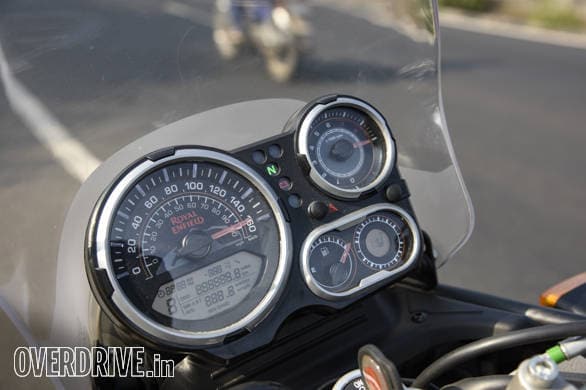 The Royal Enfield Himalayan instruments are a bit dense. The speedo especially so though you do get used to the packed digital readout. I'd move the hazard switch to the right hand switch set and chuck the compass for a charger socket, though
The Royal Enfield Himalayan instruments are a bit dense. The speedo especially so though you do get used to the packed digital readout. I'd move the hazard switch to the right hand switch set and chuck the compass for a charger socket, though
The instruments on the Royal Enfield Himalayan are comprehensive, but messy. The digital readout below the speedometer you get used to and it's packed with information. I don't mind the smaller tachometer and fuel gauge of either - though their heavily graded faces make reading the meters needlessly hard. The compass is entirely without utility and a charging socket there would have had vastly greater utility value. Royal Enfield also have a hazard switch in there which should really be at the rider's thumb. It's a cluttered, busy design that I find at odds with this simple, industrial motorcycle. It's like the word 'Fuel' that appears on the gas tank cap. Why? It's as if the designer got bored of simplicity one day and went off on a tangent for three-four aggregates.
Finally, a note of caution. First, the neutral light is lit as part of the self-check even if the bike is in gear. On our test bike, the clutch lever disengaged drive a little bit after the clutch switch meant to prevent the bike from starting without the clutch pulled in. This and the illusory promise of the self check neutral light allowed two people to start the bike in gear. It nearly fell both times - you've been warned.
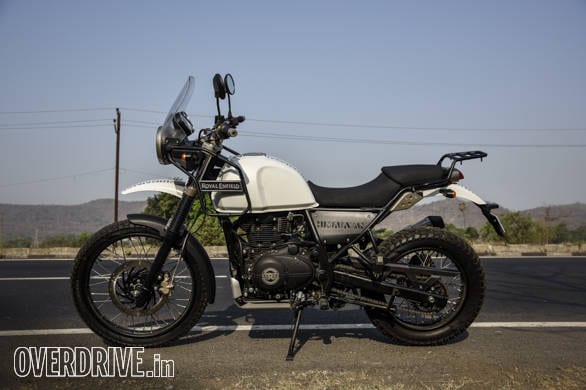 The paint finish is excellent and feels durable but the surface is slippery on the Royal Enfield Himalayan
The paint finish is excellent and feels durable but the surface is slippery on the Royal Enfield Himalayan
Second but last, the center stand. If Royal Enfield is offering this as an accessory, please do not buy it. It messes with the chain and worse, is the hardest center stand we have ever used. If this were my motorcycle, it would join the saree guard and the crash guard in the scrap heap.
Verdict
Royal Enfield's first all-new motorcycle in decades is a good one. The Himalayan is without doubt the best Royal Enfield money can buy. Its stellar chassis and adequate engine is a package that I'd be happy to recommend buying to any reader who asked. For the price, Rs 1.8 lakh, on-road Mumbai approximately, I think it's the best RE deal. I suspect many RE owners will replace their machines or expand their garages. I also expect that the adventure tourer as an idea and the native ability of the Himalayan should help it find a lot of homes that have never included Royal Enfield before. Hell, my garage would have been one of them, but for 10 more PS and ABS brakes.
 No water crossings to be found in hot, summer but the clearance, upswept exhaust and relatively high air box intake promise unstoppable fording
No water crossings to be found in hot, summer but the clearance, upswept exhaust and relatively high air box intake promise unstoppable fording
But what really bugs me is that this motorcycle could have been great, rather than just good. With the crispness of a fuel injection system, 10 more horses and a healthier sounding engine, the Himalayan would not just have been the best Royal Enfield of all, but it might have been the most purchase-worthy, drool-inducing premium motorcycle of them all in India. A motorcycle that would thrill owners and strike dumb all of Royal Enfield's usual army of detractors.
This does imply that the company would have to resolve the Himalayan's position in the range differently. It would rival the Continental GT in price and leave it far, far behind in sales. Its essential modernity, no matter how retro the flavour, would probably require it to be a new branch in the family tree. A new sprouting that doesn't go the same way as the rest of this tree. Would this have been a risky move? Not really. Royal Enfield's primary sales come from its heritage lines and I can't see the current Himalayan, or my fictional 35PS one, fundamentally altering that balance in short order.
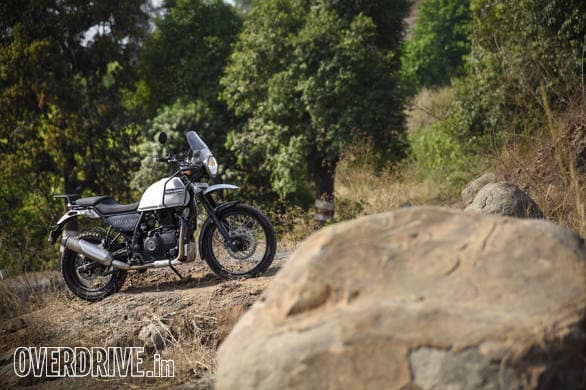 The Royal Enfield Himalayan is a good motorcycle, the company's best of all by miles. It could have been great instead of good and that's what bugs us, really
The Royal Enfield Himalayan is a good motorcycle, the company's best of all by miles. It could have been great instead of good and that's what bugs us, really
Would this require courage? Yes it would. But as Royal Enfield has shown again and again, courage isn't a quality they lack. So why the Himalayan chooses to use such a modest engine to power such a potent motorcycle will perhaps remain an unanswered question. And now if you'll excuse me, I'm off to ride India's most off-road capable motorcycle right now a little bit more before I've to return it.
Also read:
2016 Royal Enfield Himalayan detailed specifications
2016 Royal Enfield Himalayan first ride review
Image gallery: 2016 Royal Enfield Himalayan first ride review
Royal Enfield Himalayan: Things that thrill and things that don't
Spied: Royal Enfield Himalayan on the assembly line
Royal Enfield Himalayan gets ready for debut
Royal Enfield Himalayan to be showcased in India on February 2, 2016
Royal Enfield Himalayan unveiled
Image gallery: Royal Enfield Himalayan
Videos: 2016 Royal Enfield Himalayan
Starts Rs 2,01,000
411cc
5-Speed
24.50
32.00
-NA-
